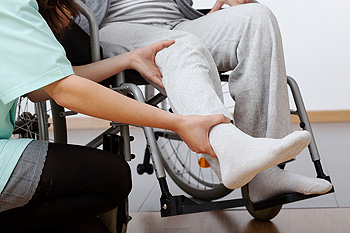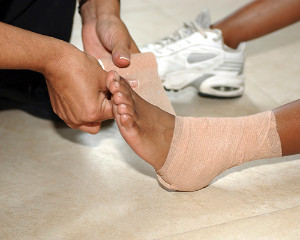 Rheumatoid arthritis usually affects small joints first, but it can move to larger joints, such as ankles. If this condition spreads to the ankles, then it can hinder one’s ability to walk, and cause extreme discomfort. Symptoms of rheumatoid arthritis usually come in flares that can last anywhere from a couple days to a couple weeks. These symptoms include inflammation and stiffness in the joints of the ankle. If this goes untreated, then this condition has the potential to permanently change the structure of the ankle joints. Rheumatoid arthritis also breaks down cartilage in the ankle that protects the bones from rubbing together, so this may create friction that will cause further weakness and instability. Oftentimes, people with rheumatoid arthritis in the ankles also experience symptoms in their feet. If you feel that you may have rheumatoid arthritis in either your feet or ankles, then it is strongly recommended that you consult with a podiatrist to receive treatment.
Rheumatoid arthritis usually affects small joints first, but it can move to larger joints, such as ankles. If this condition spreads to the ankles, then it can hinder one’s ability to walk, and cause extreme discomfort. Symptoms of rheumatoid arthritis usually come in flares that can last anywhere from a couple days to a couple weeks. These symptoms include inflammation and stiffness in the joints of the ankle. If this goes untreated, then this condition has the potential to permanently change the structure of the ankle joints. Rheumatoid arthritis also breaks down cartilage in the ankle that protects the bones from rubbing together, so this may create friction that will cause further weakness and instability. Oftentimes, people with rheumatoid arthritis in the ankles also experience symptoms in their feet. If you feel that you may have rheumatoid arthritis in either your feet or ankles, then it is strongly recommended that you consult with a podiatrist to receive treatment.
Ankle pain can be caused by a number of problems and may be potentially serious. If you have ankle pain, consult with Dr. Barbara Kilkenny from Barbara A. Kilkenny, DPM. Our doctor will assess your condition and provide you with quality foot and ankle treatment.
Ankle pain is any condition that causes pain in the ankle. Due to the fact that the ankle consists of tendons, muscles, bones, and ligaments, ankle pain can come from a number of different conditions.
Causes
The most common causes of ankle pain include:
Symptoms
Symptoms of ankle injury vary based upon the condition. Pain may include general pain and discomfort, swelling, aching, redness, bruising, burning or stabbing sensations, and/or loss of sensation.
Diagnosis
Due to the wide variety of potential causes of ankle pain, podiatrists will utilize a number of different methods to properly diagnose ankle pain. This can include asking for personal and family medical histories and of any recent injuries. Further diagnosis may include sensation tests, a physical examination, and potentially x-rays or other imaging tests.
Treatment
Just as the range of causes varies widely, so do treatments. Some more common treatments are rest, ice packs, keeping pressure off the foot, orthotics and braces, medication for inflammation and pain, and surgery.
If you have any questions, please feel free to contact our office located in Southbury, CT. We offer the newest diagnostic and treatment technologies for all your foot care needs.
Read more about Ankle Pain
 Fungal nail infection (onychomycosis) is one of the most common nail disorders among adults. It is a mycotic infection that occurs underneath the nail plate. The nail can become deformed, lifted, brittle, and discolored. These symptoms may lead to acute pain in the toenail area. There are various types of fungal nail infections and various types of treatments. One form of treatment is laser therapy, which also consists of varying methods. Photodynamic therapy uses light irradiation and a photosensitizing drug to find specific cells and destroy them. Other laser therapies that involve neodymium yttrium-aluminum-garnet or low-level lasers aim to selectively hinder fungal growth. Laser therapies are selective to the localized infection, which decreases the chance of systemic side effects. If you are interested in laser treatment for a fungal infection, consult with a podiatrist for further guidance.
Fungal nail infection (onychomycosis) is one of the most common nail disorders among adults. It is a mycotic infection that occurs underneath the nail plate. The nail can become deformed, lifted, brittle, and discolored. These symptoms may lead to acute pain in the toenail area. There are various types of fungal nail infections and various types of treatments. One form of treatment is laser therapy, which also consists of varying methods. Photodynamic therapy uses light irradiation and a photosensitizing drug to find specific cells and destroy them. Other laser therapies that involve neodymium yttrium-aluminum-garnet or low-level lasers aim to selectively hinder fungal growth. Laser therapies are selective to the localized infection, which decreases the chance of systemic side effects. If you are interested in laser treatment for a fungal infection, consult with a podiatrist for further guidance.
Laser treatment can be an effective way to get rid of toenail fungus. If you have any questions about laser treatment, consult with Dr. Barbara Kilkenny from Barbara A. Kilkenny, DPM. Our doctor will assess your condition and provide you with quality treatment for fungal nails.
What are Toenail Fungal Infections?
Onychomycosis, or fungal infection of the nail, is a relatively common and non-serious condition. Around 10 percent of U.S. citizens are afflicted with fungal nails. Common forms of fungus that infect the nail include dermatophytes, yeasts, and molds.
Symptoms of Toenail Fungal Infections Include:
Diagnosis for Fungal Nails
Fungal infections are diagnosed by fungal culture and microscopy. This will rule out any other conditions such as nail trauma, psoriasis, lichen planus, and onychogryphosis.
What is Laser Treatment?
Laser treatment is a non-invasive, safe, quick, and painless procedure that uses the heat from a laser to kill fungus in the nail. Each infected nail is targeted with a laser for several minutes. The treatment is usually utilized several different times over a select period. During this time, a podiatrist will keep an eye on the infection.
If you have any questions, please feel free to contact our office located in Southbury, CT. We offer the newest diagnostic and treatment technologies for all your foot care needs.
Read more about Laser Treatment for Fungal Nails The medical term that is referred to as hallux valgus is commonly known as a bunion. This foot condition occurs when the big toe leans toward the toe next to it, and the result may be a bony protrusion that extends on the side of the big toe. There are additional symptoms that may be associated with this ailment, which may include swelling in the affected joint, the skin becoming callused and red, which may be a result of the two toes overlapping, or possibly changes in the foot structure. Many patients notice pain may derive from wearing shoes that no longer fit comfortably. There may be several causes of bunions, and these may include an inherited trait, wearing shoes that do not have adequate room for the toes to move freely in, or possibly a medical condition such as gout or rheumatoid arthritis. If you feel you have developed a bunion, it is strongly suggested that you seek the counsel of a podiatrist who can begin the correct treatment for you.
The medical term that is referred to as hallux valgus is commonly known as a bunion. This foot condition occurs when the big toe leans toward the toe next to it, and the result may be a bony protrusion that extends on the side of the big toe. There are additional symptoms that may be associated with this ailment, which may include swelling in the affected joint, the skin becoming callused and red, which may be a result of the two toes overlapping, or possibly changes in the foot structure. Many patients notice pain may derive from wearing shoes that no longer fit comfortably. There may be several causes of bunions, and these may include an inherited trait, wearing shoes that do not have adequate room for the toes to move freely in, or possibly a medical condition such as gout or rheumatoid arthritis. If you feel you have developed a bunion, it is strongly suggested that you seek the counsel of a podiatrist who can begin the correct treatment for you.
If you are suffering from bunions, contact Dr. Barbara Kilkenny of Barbara A. Kilkenny, DPM. Our doctor can provide the care you need to keep you pain-free and on your feet.
What Is a Bunion?
A bunion is formed of swollen tissue or an enlargement of boney growth, usually located at the base joint of the toe that connects to the foot. The swelling occurs due to the bones in the big toe shifting inward, which impacts the other toes of the foot. This causes the area around the base of the big toe to become inflamed and painful.
Why Do Bunions Form?
Genetics – Susceptibility to bunions are often hereditary
Stress on the feet – Poorly fitted and uncomfortable footwear that places stress on feet, such as heels, can worsen existing bunions
How Are Bunions Diagnosed?
Doctors often perform two tests – blood tests and x-rays – when trying to diagnose bunions, especially in the early stages of development. Blood tests help determine if the foot pain is being caused by something else, such as arthritis, while x-rays provide a clear picture of your bone structure to your doctor.
How Are Bunions Treated?
If you have any questions, please feel free to contact our office located in Southbury, CT. We offer the newest diagnostic and treatment technologies for all your foot care needs.
Read more about Bunions Choosing the correct running shoe is crucial in protecting the feet while pursuing an active hobby or sport. One of the first things to do is to determine what type of running style you intend to pursue, as this can aid in selecting the shoes that are most comfortable and supportive for you. There are shoes specifically designed for different types of running, and these can include jogging on hard surfaces, running on trails, which may have rocks and other obstacles, or running where balance is required. Research has shown that it may be beneficial to recognize any patterns in how the shoes are wearing. This may be helpful in determining which type of shoe is best for you. If you would like additional information on how to choose a running shoe that is right for your feet and needs, speak to a podiatrist who can properly guide you.
Choosing the correct running shoe is crucial in protecting the feet while pursuing an active hobby or sport. One of the first things to do is to determine what type of running style you intend to pursue, as this can aid in selecting the shoes that are most comfortable and supportive for you. There are shoes specifically designed for different types of running, and these can include jogging on hard surfaces, running on trails, which may have rocks and other obstacles, or running where balance is required. Research has shown that it may be beneficial to recognize any patterns in how the shoes are wearing. This may be helpful in determining which type of shoe is best for you. If you would like additional information on how to choose a running shoe that is right for your feet and needs, speak to a podiatrist who can properly guide you.
If you are a runner, wearing the right running shoe is essential. For more information, contact Dr. Barbara Kilkenny from Barbara A. Kilkenny, DPM. Our doctor can provide the care you need to keep you pain-free and on your feet.
Choosing the Right Running Shoe for Your Foot Type
To increase performance and avoid the risk of injury, it is important to choose the right running shoe based on your foot type. The general design of running shoes revolves around pronation, which is how the ankle rolls from outside to inside when the foot strikes the ground.
If you have any questions please feel free to contact our office located in Southbury, CT. We offer the newest diagnostic and treatment technologies for all your foot and ankle needs.
Read more about Choosing the Right Running Shoe for Your Foot Type Research has shown that several athletes endure injuries to the ankles, and many of these are ankle sprains. It may also be common among the general population, and many people will experience this type of injury at some point in their lives. It generally occurs when the ankle rolls inward, and severe pain and discomfort may often accompany ankle sprains. It may happen as a result of suddenly stepping off a curb or falling from an extended height. This type of injury requires patience and time to heal properly, and walking on it must be executed gently. Once the ankle sprain has occurred, it’s important to rest the foot, which allows pressure to be taken off the ankle. Applying ice to the affected area may be helpful in alleviating a portion of the swelling that may be present, in addition to wrapping the foot in a bandage, which may be useful in applying pressure. If you have sprained your ankle, it is suggested to speak with a podiatrist as quickly as possible, so the correct treatment can begin.
Research has shown that several athletes endure injuries to the ankles, and many of these are ankle sprains. It may also be common among the general population, and many people will experience this type of injury at some point in their lives. It generally occurs when the ankle rolls inward, and severe pain and discomfort may often accompany ankle sprains. It may happen as a result of suddenly stepping off a curb or falling from an extended height. This type of injury requires patience and time to heal properly, and walking on it must be executed gently. Once the ankle sprain has occurred, it’s important to rest the foot, which allows pressure to be taken off the ankle. Applying ice to the affected area may be helpful in alleviating a portion of the swelling that may be present, in addition to wrapping the foot in a bandage, which may be useful in applying pressure. If you have sprained your ankle, it is suggested to speak with a podiatrist as quickly as possible, so the correct treatment can begin.
Although ankle sprains are common, they aren’t always minor injuries. If you need your ankle injury looked at, contact Dr. Barbara Kilkenny from Barbara A. Kilkenny, DPM. Our doctor can provide the care you need to keep you pain-free and on your feet.
How Does an Ankle Sprain Occur?
Ankle sprains are the result of a tear in the ligaments within the ankle. These injuries may happen when you make a rapid shifting movement while your foot is planted. A less common way to sprain your ankle is when your ankle rolls inward while your foot turns outward.
What Are the Symptoms?
Preventing a Sprain
Treatment of a Sprain
In many cases, the RICE method (Rest, Ice, Compression, and Elevate) is used to treat ankle sprains. However, you should see a podiatrist to see which treatment option would work best with your injury. In severe cases, surgery may be required.
It is important to ask your doctor about rehab options after you receive treatment for your injury. Stretching, strength training, and balance exercises may help the ankle heal while also preventing further injury.
If you have any questions, please feel free to contact our office located in Southbury, CT. We offer the newest diagnostic and treatment technologies for all your foot care needs.
Read more about Ankle Sprains